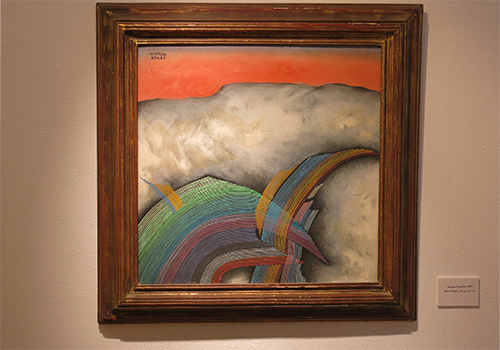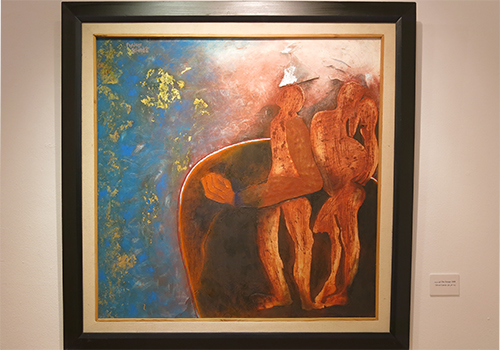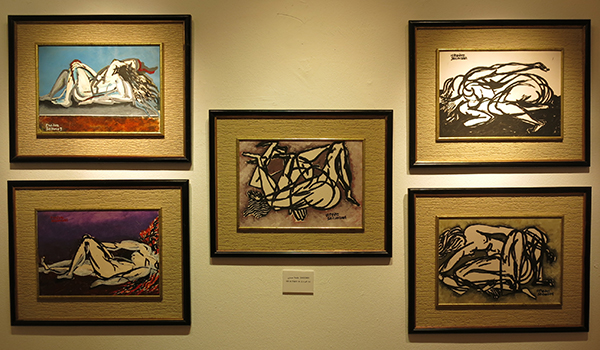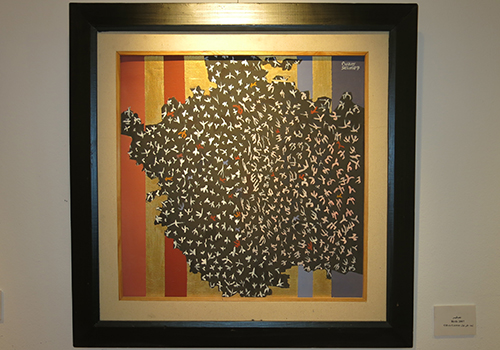On Monday, 5 January, an exhibition commemorating life and art of Egyptian artist Ahmed Fouad Selim (1937-2009) opened in Al-Bab Gallery (also referred to as Al-Bab Selim Gallery), at the Cairo Opera House grounds.
The timing and location of the event should not pass unnoticed. Not only did the exhibition open on what would be Selim's 78th birthday, but also Al-Bab Gallery was founded by the artist himself three years prior to his death.
On a crimson painted wall at the far end of the gallery, a large portrait welcomes you. Titled Marcelle, the face has the thin red lips and wide eyes of the artist's wife, Marcelle Matta, painted in Picasso-like abstraction with skin coloured blue and yellow.
Matta, who picked the paintings closest to her heart while trying to display Selim’s work from different periods, chose the exhibition's pieces, ranging from the 1960s to his last days in 2009.
Selim's subjects span from music to calligraphy and to nudes. We are presented abstract works with an earthy palette, and figures that echo cubism.
In a catalogue accompanying the exhibition, art critic Samir Farid, who knew the artist personally, described Selim as “the artist who played notes with a brush and pen, and painted music.”
A number of pen on paper sketches depict musicians and their instruments, with energetic pen strokes. In one of the pieces Selim employs the futurist style of expressing movement, rendering a pianist as having multiplied pairs of hands across the keys, translating the energy of a musical performance.

The Soprano by artist Selim (photo: Soha Elsirgany)
Music inspired Selim’s art and was long infused in his personal life. With Matta a pianist, it is no surprise that their daughter, Amira Selim, is a soprano singer of international renown.
No surprise, then, there are two works depicting sopranos hanging at the gallery: one a depiction of the artist’s daughter, singing Queen of the Night in Mozart's opera The Magic Flute.
The other soprano piece has neither musicians nor instruments, despite holding the musical title. This one is an abstract painting. Part of a collection previously exhibited and undoubtedly sold-out, the piece offers the artist’s interpretation of music — a response to it rather than a depiction of its players.
The nudes collection falls under his more recent works, dating between 2001 and 2009, including a number that Selim created in his last stay with the family in Ain El-Sokhna.
“At this point he was quite tired from his illness, but we encouraged him to keep drawing,” Matta told Ahram Online.
There are other works from Selim’s last years, most notably the two pieces titled The Escape.
While more effective had they been displayed side by side, the common title links them and piques the viewer’s curiosity as to what the escape implies.
“Perhaps he was tired of life in that last year, and was thinking of an escape from the pain,” speculates Matta.

The Escape by artist (Photo: Soha Elsirgany)
Despite having a lot to say about the art scene, with a career in art criticism in various publications and having written books about art, Matta says that Selim wasn’t an artist to explain his artwork explicitly, leaving it to the senses.
Titled The Birds, another piece was painted in the same timeframe as The Escape. Birds have long held close to notions of freedom. Now, after his loss, one can only guess what he was expressing in those last works.
Selim’s very last painting remains unfinished, framed in the gallery close to the exit.
Divided in horizontal thirds, blue skies are covered in a wash of red paint, a yellow and white lower section resembles sandy grounds, and the middle section is black, with what seems like bodies trapped behind crosshatched penstrokes.
“He told me, 'I’m still going to finish this piece.' Then shortly after he went into hospital and passed away,” says Matta.
An award winning artist, not all of Selim’s life achievements can be framed in the gallery; the man behind the artwork was much more than that, playing a pivotal role in shaping the Egyptian art movement from the 1960s onward.
“The picture and the word are my salvation in this world,” the late artist is quoted as saying in the catalogue. “A society half alive is dragging its other dead half. How could we bring life to the whole body?” Selim asks.

Nudes collection by artist Selim (Photo: Soha Elsirgany)
His legacy answers that question, as he endeavoured to bring life to the whole body, by devoting his personal and professional life to spreading contemporary art across society, and worked to establish centres for art.
Selim was the initiator of the now International Cairo Biennale, which started in 1984, seven years after submitting his proposal to the General Organisation of Arts and Literature.
He also established the One-Hundred Seat Theatre, and directed The Zamalek Art Centre until the year 2005, in which he then started directing the Museum of Egyptian Modern Art until his death.
In the words of artist Mostafa El-Razzaz, written in the catalogue: “Against conventionalism, he [Selim] was an activist and an initiator in intellectual and cultural activities.”
With Matta not being a professional curator, the exhibition is purely the labour of love, driving forward the flow of the exhibition and its logistics.
Some of the pieces are exhibited for the first time, which renders them very special, though at times one cannot always tell if they were meant as sketches or considered by the artist finished works.
The exhibition nonetheless does serve its essential purpose, which is to remember the artist, celebrate him and appreciate his role in empowering the art scene and artists through his creative vision.

The Birds by artist Selim (Photo: Soha Elsirgany)
Programme:
The exhibition is open until 15 January, daily except Fridays, from 10am to 3pm and from 5pm to 9pm.
Al-Bab Gallery, Cairo Opera House grounds.
Short link: